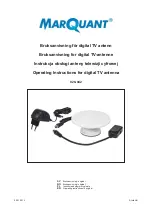
Troubleshooting
© Philex Electronic Ltd. 2008. v1
32 Element Digital Aerial with
4 Room Distribution Kit
USER GUIDE
Introduction
Customer Careline 08457 573479
Congratulations on the purchase of your aerial and distribution kit. The kit is designed to receive and distribute
both analogue and digital terrestrial signals around your home to up to 4 TVs without loss of signal strength.
This aerial has been manufactured to the standard required to get the best reception of digital terrestrial TV
services (e.g. Freeview™). If the aerial is to be used for DTT reception check before installation at
www.digitaluk.co.uk/ to confirm that your home is in a coverage area and to find where your local
transmitter is. This kit contains all the items necessary for mounting the aerial to an existing mast or for
mounting externally to eaves or a wall or mounting in a loft. This kit also contains digital type coax cable to
ensure good reception.
Aerial Features
•
Wideband – suitable for all UK TV reception areas, covering UHF channels 21 to 68
•
Receives both digital and analogue TV signals
•
Perfect for use in the majority of locations although in very high strength signal areas an
attenuator may be required, or for very weak strength signal areas an amplifier may be needed
The aerial requires some assembly - please read these instructions carefully before beginning.
CAUTION: When mounting the assembled aerial, always observe safety precautions and use the
correct equipment. Unless you are competent in the use of ladders and other access equipment,
do not work outdoors at roof height. If in any doubt, refer to a qualified aerial installer.
A. Fitting the dipole assembly
1. The dipole clips onto the central
boom. Ensure that the cable exit hole
(from the terminal box) faces the rear
of the aerial and that the locating stud fits
into the locating hole on the boom as
shown in Fig. 1.
B. Rotating the aerial elements
1. Rotate the elements about the
central fixing clip until they
‘snap’ into an upright position as
shown in Fig. 2.
LAB32KIT/S
Analogue Terrestrial TV
Snowy Picture
A faint, grainy or snowy picture is generally caused by
a weak signal. Normally the TV transmitter will be a
long way away. A possible improvement could be made
by reducing the aerial downlead losses, installing a
high gain aerial and by adding a low noise masthead
amplifier or signal booster. In a small number of cases, a
snowy picture can also be caused by a TV signal that is
too strong.
‘Herringbone’ Pattern
‘Herringboning’ is generally caused by too strong a TV
signal or by a local high power transmitter such as CB,
amateur or taxi radio. Your TV sound may be affected as
well as the picture. Using an attenuator will reduce the
gain of an aerial signal and improve the overall picture.
Digital Terrestrial Television
Unlike analogue TV signals which can still be viewed
under weak signal strength conditions, with digital
terrestrial signals blocking/freezing and/or loss of digital
picture and sound can be caused by insufficient digital
signal and carrier to noise ratio.
Similarly blocking and even a completely blank screen
with no sound can result if the input signal to the set
top box is too high. The digital cliff refers to the rapid
change from the picture and sound being perfect, to
disappearing altogether.
For specific help with DTT reception problems,
log onto *
www.digitaluk.co.uk/
No picture:
Check all connections from aerial to TV.
Poor picture:
Check all connections from aerial to TV.
Check aerial is properly aligned to the correct
transmitter.
If the aerial has been loft mounted try mounting
outside.
Make sure new digital coax cable has been used
throughout the installation.
Check the transmitter signal is not obstructed by nearby
trees or buildings.
If in a very weak signal area or for long cable runs,
installing a masthead amplifier will improve the signal.
If in a strong signal area the signal strength may need to
be reduced by fitting an attenuator.
Intermittent Picture:
Make sure all RF cable to
connector joints are tight (both inner and outer)
including all flyleads and surface outlet connections.
To Prevent Overheating
The recommended clearances and other precautions
given in the installation section of these instructions
must be observed to prevent overheating.
In addition, the amplifier should not be fixed where it is
likely to become smothered by curtains or other fabrics,
etc, or other thermal insulation materials in a roof space
or similar building void. The unit should not be left
resting on a carpet.
Cable Installation
Do not install cable -
Closer than 50mm to mains or
telephone wiring.
Under carpets in areas likely to be walked on regularly.
With sharp bends at corners
.
Other Precautions
Apart from the aerial and cable all other parts of the kit
are not waterproof and are for indoor use only.
They must not be fixed where they could be exposed to
dripping or splashing water. Objects containing liquids
should not be placed on or near the appliance.
To prevent risk of fire, no object with a naked flame
should be placed on or near the appliances or the wiring
to them.
Fitted Mains Plug
The amplifier is supplied with a standard fixed plug
already fitted. In the unlikely event that you need to
change the fuse in this plug, a 3Amp fuse to BS1362
carrying the ASTA or BSI approved mark must be used.
General Safety Precautions
For further information or any queries please contact
Customer Careline: 08457 573 479
(Local rate – UK only)
www.labgear.com
Waste electrical products should not
be disposed of with household waste.
Please recycle where facilities exist.
Check with your Local Authority or
retailer for recycling advice.
Labgear
rotate elements
locating hole
locating stud
rear of aerial
element
in upright
position
central boom
dipole
Fig. 2
Fig. 1
Aerial assembly and mounting




















